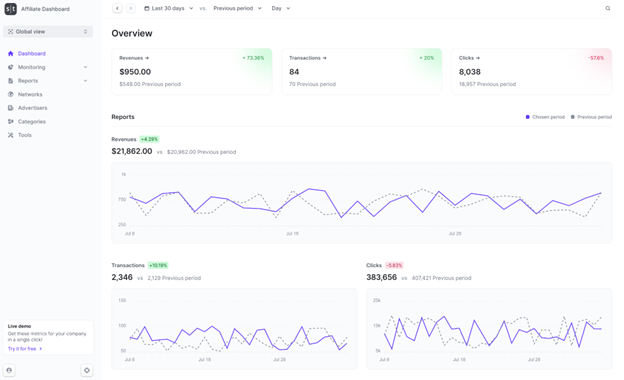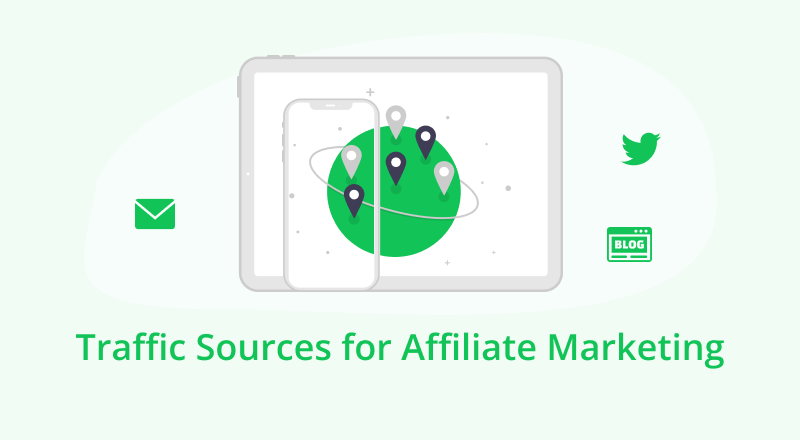Table of contents
Helpful Summary
-
Overview: This article explores the most effective traffic sources for affiliate marketing, discussing their benefits, strategies, and how to maximize your earnings through these channels.
-
Why You Can Trust Us: Strackr's integration with over 221 affiliate networks provides us with comprehensive insights into traffic performance across various marketing channels.
-
Why It Matters: Choosing the right traffic sources as an affiliate marketer can greatly boost your success, increasing your reach and conversions.
-
Action Points: We recommend diversifying your traffic sources, focusing on those fitting your niche the best, and using Strackr to track and optimize your performance across channels.
-
Further Research: Analyze successful affiliate marketers in your niche, try out different traffic sources, and use Strackr's unified dashboard to measure and compare how well each channel works.
Curious About the Top Traffic Sources for Affiliate Marketing?
Strategically choosing traffic sources is one of the best ways to find success with affiliate marketing. In fact, a recent study found that affiliate marketers who diversify their traffic sources see an average of 30% higher ROI compared to those relying on a single channel.
Talk about a game-changer!
So, how can affiliate marketers tap into these powerful traffic streams? Buckle up as Strackr dives into the world of top-performing traffic sources. By the end, you’ll have a solid understanding of the pros and cons of each of these six options.
Why Trust Us?
Strackr has revolutionized affiliate marketing analytics, especially for marketers managing multiple traffic sources. Our Google analytics tool helps you to understand your traffic sources better: how visitors use your site, which page triggers them to buy, and more.

Our platform also tackles common issues like data fragmentation and inefficient reporting, as demonstrated by an affiliate marketer who consolidated data from social media, SEO, and paid ads into one interface, saving time and gaining deeper insights
Similarly, a niche product reviewer used our unified analytics to optimize their traffic strategy, boosting affiliate revenue by 40%. Strackr's holistic view of traffic performance helps affiliate marketers to make data-driven decisions and leverage various channels.
What Are Traffic Sources for Affiliate Marketing?
Traffic sources for affiliate marketing are the channels and methods you use to drive potential customers to affiliate offers.
These are the pathways that lead people to discover your content, click on your affiliate links, and make purchases that earn you commissions. Think of them as the roads that bring visitors to your digital storefront.
If you're new to affiliate marketing, check out our comprehensive guide on getting started with affiliate marketing to get up to speed on the basics. Once you’re done, head back here for an in-depth review of a few of the best affiliate marketing traffic sources.
Why Choosing the Right Traffic Sources Matters in Affiliate Marketing

Let's face it—traffic is the lifeblood of any affiliate marketing campaign. Your traffic sources can range from SEO, social media to email traffic.
Here's why focusing on the right traffic sources as an affiliate marketer is important:
-
Targeted Audience: The right traffic sources help you reach people who are actually interested in your offers, increasing your conversion rates.
-
Cost-Effectiveness: Some traffic sources provide better ROI than others, allowing you to maximize your marketing budget.
-
Scalability: Certain traffic sources can be easily scaled up as your affiliate business grows.
For more insights on maximizing your affiliate income, don't miss our article on proven strategies to increase your affiliate revenue.
Things to Consider When Choosing Traffic Sources
To get the most out of your traffic sources, it’s important to consider some key factors. So make sure to keep the following in mind:
-
Your Niche: Different niches perform better on different platforms. Also, research where similar businesses in your niche are being successful.
-
Your Budget: Some traffic sources require more financial investment than others. Plan your budget according to your long-term goals and expected returns.
-
Your Skills: Certain traffic sources may need you to have specific skills or expertise. Assess your current skills and consider if you need additional training or support.
-
Your Time: Consider how much time you can dedicate to managing each traffic source. Make sure you have time to effectively maintain each source.
-
Your Target Audience: Choose sources where your ideal customers spend their time online. Tailor your approach based on where your audience is most active and engaged.
6 Best Traffic Sources for Affiliate Marketing
Now, let's dive deep into the cream of the crop—the traffic sources that can supercharge your affiliate marketing efforts!
1. Search Engine Optimization (SEO)
SEO is like the slow-cooking method of affiliate marketing—it takes time, but the results are worth it. To pull it off, you create content around affiliate products and services. Then, you optimize that content for search engines so that when someone searches for related keywords, your content appears at the top of the results.
-
Cost: Low (mainly time investment)
-
Time to Results: Long-term (3-6+ months)
-
Skill Level Required: Medium to high
-
Best For: Any kind of product or service
There are all kinds of content you can create as part of an affiliate SEO strategy—from review and comparison blogs to alternatives landing pages and find-a-product quizzes. The key is to find a niche and target specific keywords that are relevant to the products or services you are promoting.
Key strategies for SEO success in affiliate marketing:
- Keyword Research: Use tools like Semrush or Ahrefs to find high-volume, low-competition keywords related to your affiliate products.
- Quality Content: Create in-depth, valuable content that answers your audience's questions and naturally incorporates your target keywords.
- Link Building: Develop a strategy to earn backlinks from reputable websites in your niche.
- User Experience: Ensure your website is fast, mobile-friendly, and easy to navigate.

Pro Tip: Use Strackr's data analysis feature to monitor the performance of your SEO affiliate strategy by adding the websites you publish SEO content to. This can help you track which sites are driving the most traffic and conversions.
2. Social Media Marketing
Social media platforms are bustling marketplaces where you can connect with potential customers, grow your brand, and drive traffic to your affiliate offers. From Instagram to TikTok, each platform comes with one-of-a-kind opportunities.
-
Cost: Low to medium (can be free or paid)
-
Time to Results: Short to medium-term
-
Skill Level Required: Low to medium
-
Best For: Products with visual appeal, lifestyle niches, trending products
Social media marketing for affiliate offers can involve organic posting, paid advertising, or a combination of both. Each platform has its own strengths:
-
Facebook: Great for detailed targeting and a wide range of ad formats.
-
Instagram: Ideal for visually appealing products and influencer partnerships.
-
Pinterest: Perfect for DIY, home decor, fashion, and other visually-driven niches.
-
TikTok: Excellent for reaching younger audiences and leveraging viral trends.
-
LinkedIn: Best for B2B products and professional services.
Key strategies for social media success:
- Choose the Right Platforms: Focus on platforms where your target audience is most active.
- Create Engaging Content: Use a mix of promotional and value-added content to keep your audience engaged.
- Leverage Platform Features: Use stories, reels, live videos, and other platform-specific features to maximize engagement.
- Engage with Your Audience: Respond to comments, run polls, and create interactive content to build a community.
3. Pay-Per-Click (PPC) Advertising
PPC advertising, like Google Ads or Bing Ads, allows you to place your affiliate offers in front of people actively searching for related products or services. It's like putting up a billboard exactly where your target audience is looking.
-
Cost: Medium to high
-
Time to Results: Immediate
-
Skill Level Required: Medium to high
-
Best For: High-ticket items, competitive niches, time-sensitive offers
PPC can give quick results as a traffic source, but it requires careful management to make sure it’s profitable.
Here are some key platforms:
-
Google Ads: The largest PPC platform, offering search, display, and video ads.
-
Bing Ads: Often cheaper than Google, with a slightly different demographic.
-
Facebook Ads: Great for detailed audience targeting and retargeting.
-
Amazon Ads: Ideal if you're promoting products available on Amazon.
Key strategies for PPC success:
- Keyword Research: Choose keywords with high commercial intent.
- Ad Copy Optimization: Create compelling ad copy that stands out and accurately represents your offer.
- Landing Page Optimization: Ensure your landing pages match your ads and are optimized for conversions.
- Bid Management: Regularly adjust your bids based on performance data.
4. Email Marketing
Don't let anyone tell you email is dead—it's still one of the most effective traffic sources for affiliate marketing. Building an email list allows affiliate marketers to nurture relationships and promote affiliate deals to an engaged audience.
-
Cost: Low to Medium
-
Time to Results: Medium to long-term
-
Skill Level Required: Medium
-
Best For: All types of affiliate offers, recurring commissions
Email marketing involves building a list of subscribers and sending them regular newsletters, promotional emails, and valuable content.
Key strategies for email marketing success:
- Build Your List: Offer a valuable lead magnet to encourage sign-ups.
- Segment Your List: Divide your subscribers based on interests or behavior for more targeted campaigns.
- Provide Value: Don't just promote—share useful content that your subscribers will appreciate.
- Test and Optimize: Regularly A/B test your subject lines, email content, and send times.
5. Content Marketing
Content marketing involves creating valuable, relevant content that draws in your target audience and keeps them engaged. This can include blog posts, videos, podcasts, and more.
-
Cost: Low (mainly time investment)
-
Time to Results: Medium to long-term
-
Skill Level Required: Medium
-
Best For: Any kind of product or service
Content marketing often overlaps with SEO, as high-quality content can help improve your search engine rankings.
Key strategies for content marketing success:
- Know Your Audience: Create buyer personas to understand what content will resonate with your target audience.
- Diversify Content Types: Mix up your content with blog posts, videos, infographics, and more.
- Promote Your Content: Share your content on social media, in email newsletters, and through outreach to other websites.
- Update Regularly: Keep your content fresh and up-to-date to maintain its relevance and search engine rankings.
6. Influencer Partnerships
Collaborating with influencers in your niche can help you tap into their established audiences and add credibility to your affiliate offers.
-
Cost: Medium to high
-
Time to Results: Short to medium-term
-
Skill Level Required: Low (but requires good networking skills)
-
Best For: Physical products, lifestyle offers, new product launches
Influencer marketing can range from micro-influencers with a few thousand followers to major celebrities with millions of fans.
Key strategies for influencer partnership success:
- Choose the Right Influencers: Look for influencers whose audience aligns with your target market.
- Build Relationships: Don't just transact—build genuine relationships with influencers in your niche.
- Create Authentic Campaigns: Work with influencers to create content that feels natural and authentic to their audience.
- Track Results: Use unique tracking links or promo codes to measure the success of each influencer partnership.
Conclusion
We've explored a range of powerful traffic sources for affiliate marketers, from SEO to influencer partnerships. Each traffic source has its own benefits and challenges.
Whatever you’re considering, whether it’s SEO or influencer marketing, tools like Strackr can help streamline your efforts. Centralize your affiliate marketing efforts with Strackr and unlock better analytics, deeper insights, and more reliable results.
Share
Affiliate dashboard

Connect all your affiliate networks with Strackr to access to unified statistics and tools.
Try for free